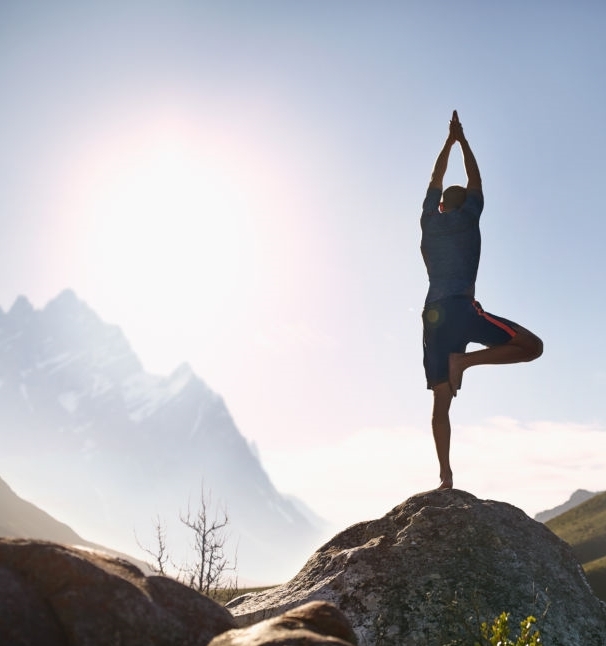Balancing asanas can bring an amazing sense of freedom, strength and discipline but can be challenging – mostly for the mind. We pick a point to focus on but then the mental commentary starts, and rattles us!
Quite often we hear a lot of utterances of annoyance and frustration around us at this part of the practice too. Digging a bit deeper, this reveals a lot about our mental commentary or sense of ‘ahimsa’ (non-violence) toward ourselves, not just in practice,` but also in daily life. Practicing Ahimsa is one of the foundations of a well rounded yoga practice, and bringing our awareness to how this can be tested helps us develop not just our practice but also our inner peace and resilience.
Ayurveda reveres fire or agni - it is the metaphor for all metabolic functions in the body. Agni plays a vital role in our digestion, perception, taste, touch, hearing, sense of vitality, mental clarity and alertness. When agni and the functions it supports are balanced it brings about a beneficial state of health. We are sharper, clearer, more energetic and strong and feel more cheerful, confident and optimistic. When agni is imbalanced we typically feel an imbalanced state of health – heavy, slow, congested, sluggish, dull and experiencing frustration, anger, and fear.
The transitory time between seasons, ‘Ritu Sandi’, the point where two seasons meet is a significant time in the ayurvedic approach to well-being. In this time, a short period of cleansing out any accumulations from one season before welcoming the other is recommended.
Read MoreA typical summer season in Melbourne brings intense heat and dryness mixed up with days of cold and rainy weather. This erratic weather can lead to aggravations of your doshas (elemental balance) particularly vata and pitta in your body, leading to fatigue, dizziness, inflammation and headaches with the heat and patterns of dry skin, dry lips, flare-ups of dry eczema, dry coughs and cracked soles of the feet with the dryness.
Ayurveda teaches us to live in unison with this time of year rather than fight it by adjusting lifestyle, habits, food and drink, exercise, yoga and breathing to bring about major shifts to well being.
Here are some key things to remember in keeping the doshas in check from a dietary and lifestyle perspective…
Read MoreThe 2nd of October each year marks the International Day of Non-Violence. This is the birthday of Mahatma Gandhi, leader of the Indian independence movement and pioneer of the philosophy and strategy of non-violence.
This day is of particular importance in current times, with all of the pain and suffering, injustice and intolerance we see around us in so many parts of the world. Violence and a disruption of peace happens in many forms and on many levels – it happens within us when we are at odds with ourselves, around us when we are at odds with others, and on a mass level when society is at odds with nature, and groups are at odds with each other.
So what can we do as yogi’s to play our part in making a difference today and everyday? This is where the yogic concept of ahmisa, comes into play and has never been more important. Ahimsa is a foundational concept of the eight limbed ashtanga yoga philosophy and is a Sanskrit word that is loosely defined as ‘kindness to the self’, or sensitivity, vulnerability, non violence…
Read MoreOne of the pillars of the ayurvedic philosophy is following a routine of daily activities (dinacarya) to facilitate regular clearing of accumulated toxins from the body and optimising health on a consistent, daily basis to avoid large scale build ups. Let’s look at how some of these good daily habits can be incorporated in to our lives in alignment with the current Spring season.
Spring in Australia takes place during the three transition months between Winter and Summer running from September to November. It is typically a time of increased warmth and wetness mixed with the residual cold of winter, as it thaws and melts away. Generally, the early stage of Spring is colder (on balance) and the middle to end of Spring is warmer as it edges closer to Summer.
Read MoreWe are so pleased to be involved in a project funded by the Foundation for Young Australians this year, where we’ll be running two wellness and mindfulness workshops for budding young social entrepreneurs. These young stars will receive support, training and guidance on their projects as they make their way in the world. Ananda Wellness will be running two workshops in Melbourne and Sydney with practical advice on everyday wellness, stress management and mindfulness – a big part of staying on top of your game!
Read MoreWe've had a number of chats about back, neck & shoulder aches and pains with clients in the last few weeks. Aside from being due to a specific injury, this may be due to an accumulation of tension in the area over time, stemming from poor posture. This includes how we sit, stand, sleep and carry our frames in general.
During colder months in particular, posture is impacted by us tightening up and contracting muscles to protect it from cold. The next time you are walking outside, pay attention to your shoulders and back. Many of us move the shoulders up towards the ears, ‘balling up’ and pulling inwards. This moves our upper body and neck area out of alignment leading to back and neck pains over time.
A good case in point are some communities in Northern Europe, living in some of the coldest parts of the world such as Denmark and Scandinavia. How do people living here get through cold Winters, yet come out being rated as some of the happiest people in the world? I recently learned that much of this is because of the celebration of warmth and community. The Danes have a special term for this, Hygge (prounounced ‘hooga’) meaning creating a warm atmosphere and enjoying the good things in life with good people. I had a chance to experience this around the time of the start of the Winter Solstice this year, when I attended a beautiful hygge celebration (thank you lovely Sarah), which was an evening of sharing and community.
Read MoreOne of the core principles of ayurveda is that 'like increases like'. Winter and that time in-between Winter and Spring when the cold is ‘melting’ is a time of year when the water and earth element are most dominant in nature - this is why we feel cold, heavy and blue and the incidence of phlegm, mucus, coughs and colds increase. If you are prone to these ailments and are thinking of a more natural route to healing this year, here are some handy guidelines…
Read MoreMelbourne experienced an erratic autumn with very hot days and smatterings of cold, wet and windy days. This weather may have led to aggravations of Pitta and Vata in your body and we may have experienced everything from migraines, dizziness, inflammation and fatigue on the hot days and dry skin, dry lips and eyes, cracking joints, flare-ups of eczema, dry coughs and bloating and constipation in the peak of Autumn, leading to more colds, phlegm, runny noses, headaches, fatigues, lethargy and weight gain as we get closer to winter.
Why does this happen? How do can you prevent it in the upcoming Winter Season and stay balanced and healthy all year round?
Consultations and ayurvedic wellness plans
Massage and specialised treatments
Yoga and Meditation
Workshops and classes
Read MoreFeeling heavy, tired, lack energy, muzzy headed, have dull aches/pains, joint inflammation, gas, indigestion, bloating, skin blemishes, poor circulation, foul smells (breath, sweat, urine) or tired after eating?
If yes to a combination of these, and you're told nothing's wrong you may be experiencing a build of a toxic substance called 'ama’. In Ayurveda this is defined as a build up of undigested waste from food, emotions, or the environment.
Embracing a rare bit of sunshine on a winter's day is a simple way to remain present, connect with and pay respects to nature, and get yourself a healthy dose of vitamin D! This is known as the Sunshine Vitamin, helping to maintain bone health, protect against heart disease, diabetes, and reduce pain, depression and bring about better sleep. 🌞
Read MoreAround two years ago I had a full time corporate job, taught yoga on some weeknights and worked at a busy Ayurvedic clinic on the weekends and felt unfulfilled. I am a naturally energetic person and had very full days but I felt like I was not doing enough despite feeling exhausted at the end of the day. This unrest led me to look inwards, and I had a sense that my ‘dharma’ - my purpose - was starting to beckon me to change things up and pursue something bigger than myself and my ‘Five Year Plan’.
Read More















